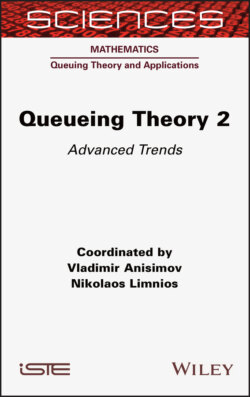Читать книгу Queueing Theory 2 - Nikolaos Limnios - Страница 19
1.8. Queueing system with a preemptive priority discipline
ОглавлениеIn this section we study a continuous-time queueing system with two independent regenerative input flows X1 and X2 with intensities λ1 and λ2 and m servers. The customers of the second type (which belong to X2 ) have an absolute priority with respect to customers of the first type. Service interruption for the low priority customer occurs when a high priority customer arrives during a low priority customer’s service time. If at an arrival time of the second type customer there are m1 free servers, m2 servers occupied by customers of the first type and m – m1 – m2 servers occupied by customers of the second type, then an arriving customer randomly chooses any server from m1 + m2 servers, which are not busy by customers of the second type. Service times by the ith server for high(low) priority customers have distribution function B0 with mean Therefore, for high priority customers we have a system Reg|G|m with homogeneous servers and for low priority customers a system with interruptions and preemptive resume service discipline considered in section 1.6.
Denote by Qi(t) the number of customers of the ith type at the system including the customers on the servers at time and be the sequences of regeneration points for X1 and X2, respectively. Under some additional conditions, for example, when the inequality [1.14] is valid for the function B0 (other sufficient assumptions are given in Afanasyeva and Tkachenko (2014)), the process Q2 is regenerative with points of regeneration
The stability condition for the process Q2 has the form (Afanasyeva and Tkachenko 2014)
[1.17]
that is supposed to be fulfilled. We now want to get the stability condition for the process Q1.
We start with the definition of the process of interruptions. Let ni(t) =0 if at instant t the ith server is occupied by a high priority customer and ni(t) = 1 otherwise, As regeneration points for , we take subsequence of the regeneration points sequence for the input flow X2 such that As before, we assume that [1.14] holds for B0. Since X2 is a strongly regenerative flow, condition 1.6 is fulfilled.
To obtain the traffic rate for low priority customers, we need to find Because of the rule of the server choose by an arriving high priority customer, we have for all To calculate π, we define for high priority customers the following processes. Let wi(t) be the residual service time (virtual waiting time) on the ith server at instant t and Zi(t) the total service time of customers which arrived up to time t and have to be served on the ith server. Thus
where ηj is the service time of the jth arrived customer. We note that w.p.1
and
because of the stability condition [1.17].
Since
and w.p.1
then Therefore, the traffic rate for low priority customers has the form
From corollary 1.1 we obtain corollary 1.3.
COROLLARY 1.3.– Assume that X2 is a strongly regenerative flow, B0 satisfies [1.14] and Then If additionally Bi satisfies [1.14] and ρ1 < 1, then Q1(t) is a stable process.
The first statement follows from corollary 1.1 since is a strongly regenerative process. To prove the second statement, we note that Q2 is a regenerative process and its stochastic boundedness means stability.
